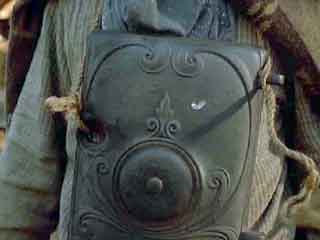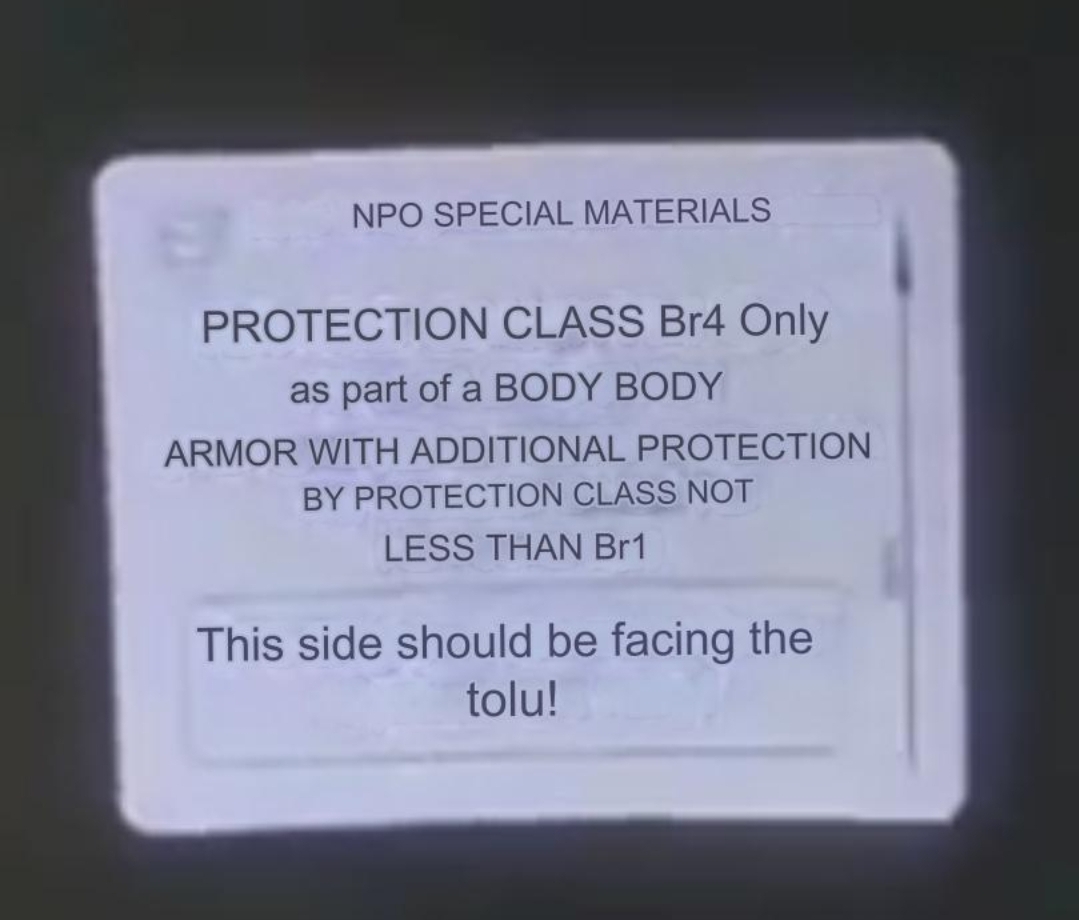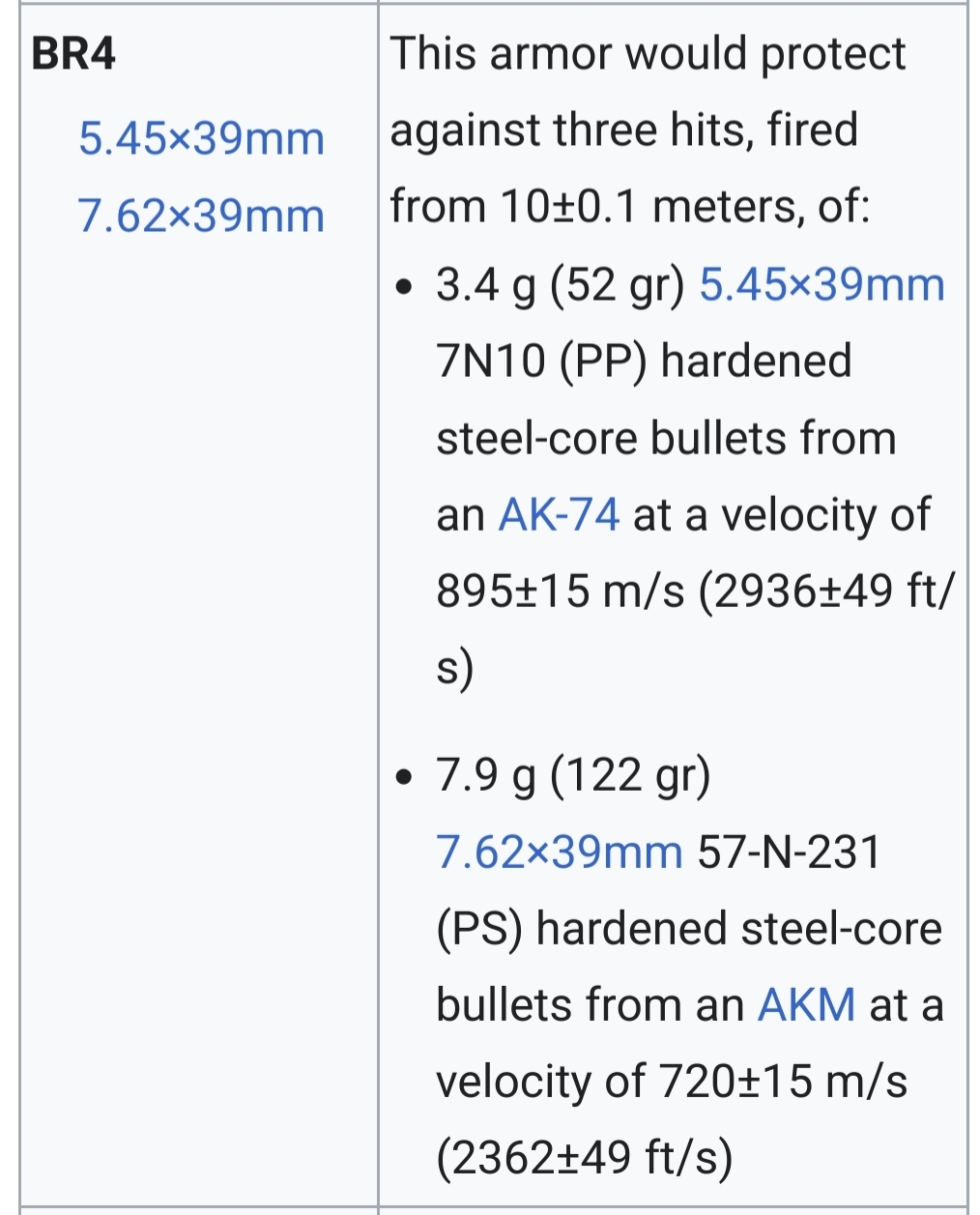They gon' have to Marty McFly that shit.

They gon' have to Marty McFly that shit.

PAN SHOT

Do you feel lucky, punk?

Gotta love that it's the work of a technical institute. I guess that's the kind of technological development they can expect after all the good scientists left that shithole.
My guess is, the institute developed a competent armor, showcased it and got the contract to build them.
Then several levels of managers and executives decided to use a bit less material, use a cheaper supplier and skip a few QC steps, pocketing the surplus contract money.
And then they re-used the vests taken off fallen soldiers several times, sewing shut the bullet holes in the cloth covering (or not).
The honest people were ran out of the organization or the country years ago - maybe through a window - until only parasites feeding off parasites remain.

Here is the translated classification of the body Armour
Someone Def skimmed off the top of the pot during production lmao
And here is the rating of BR4 body Armour 
Interesting to think that the U.S. has spent so much money to develop and test a new bullet and rifle combo specifically to beat Russian body armor, all for naught.
It’s what the US always does. Russia claims to have this or that so the US builds something to defeat it. It’s happening with China now too.
Wasn't it also for the fancy stuff that China is developing? Also this video doesn't mean that Russia hasn't produced better armour (they obviously have, that appears to be unhardened mild steel lol) , just that they can't mass produce it.
ProdigalFrog, it was a different time.
It was back when we didn’t know the Russians were incompetent.
Oh no. The US did that for China. And because it really was time for a new rifle.
lol, what material is this? just steel? five layers of tinfoil?
five layers of tinfoil
That ought to give just enough protection from the liquid that turns frogs gay, at the very least.
Maybe I just don't know how bulletproof vests work, but shouldn't there be some layers of energy dispersing material on top of that plate?
Is it a fair comparison without?
The plate should work on its own. The thing that stands out to me is there's not even deformation. None of the impact is being caught and spread out. Just perfect holes. So yeah. Well outside the envelope for where the kevlar shell would have made a difference.
By the sounds of it they just used sheet metal lol
Yup. Just classic Russian corruption where there's something in the inventory. Just not what it's supposed to be.
You might be thinking of the anti-spalling coating on the front. Not exactly required but helpful.
That layer traps the prices of the splattered bullet after it impacts the plate. Without it those pieces can hit your chin or arms.
OR you're thinking of ceramic plates? Ceramic breaks up the bullet while the Kevlar behind it catches the slowed and broken pieces.
At least for steel plate, it should work without any supporting material.
Kevlar around it would help catch spalling from a bullet flattening out and spraying little bits of shrapnel out across the surface, but since these ones aren't actually stopping the bullets, there is no spalling to catch.
That isn't good for the tree
maybe it's only pistol rated lol that should come in handy in the modern battlefield
Designed for the safe looting of home appliance stores
Clearly they just didn't believe in the vests hard enough.
You make a joke but it is true. The vest isn't meant to save troops life, it is meant to get to troop to go to the front line
I think that that's a little from column A, a little from column B.
I don't think that Russia is intentionally putting sub-par plate out there. I think that protective gear is procured with the intent of providing protection, and that if the armor doesn't meet up with what it's specified to do, that's probably because somewhere, procurement or manufacturing screwed up in Russia.
On the other hand, militaries do really spend money and are willing to accept tradeoffs on things where they cannot protect a soldier and something makes a soldier feel safer, if they feel that it'll make them more effective due to psychological impact. I remember reading about how American soldiers kept adding ad-hoc armor to tanks in WW2, sandbags and such. It wasn't very effective. But...it also made soldiers feel safer to do it, so commanders often let them go ahead with it...shrugs My guess is that at least some of the benefit of body armor is that it does make soldiers more-comfortable with taking on dangerous tasks, and that that's probably been taken into consideration.
https://old.reddit.com/r/WarCollege/comments/18hmn90/did_adding_sandbags_to_tanks_in_wwii_actually/
Only one official test of sandbags as an antidote against antitank rockets was recorded, which took place on 9 March 1945 in Europe. The side sponsons of a medium tank were covered with sandbags, and a Panzerfaust 60 was fired at it; the projectile blew away the sandbags and penetrated the armor. The same test was carried out against the glacis plate; the projectile tore off some of the sandbags but failed to penetrate the armor; whether the sandbags or armor set off the warhead or whether it ricocheted off because of the angle of attack is not specified. An Ordnance Department observer reported that "these tests are far from conclusive, and the psychological value of the sandbags is the greatest value actually derived," while another observer stated that, "I gathered that if the bags did nothing more, they were certainly a morale factor as the crews were thoroughly impressed with them" after visiting units on the front lines that used them.
Ordnance Department officials in the European Theater, meanwhile, had a mixed reception to the sandbagging effort, despite the fact that in many cases, "Tankers disagreed, citing numerous examples where sandbagged tanks were not penetrated by panzerfaust or panzerschreck hits." Third Army Ordnance personnel convinced Lieutenant General George S. Patton that the excess weight imposed on tanks by sandbags and their limited effectiveness against enemy projectiles was a net negative. Although American armored units had performed well during the Battle of the Bulge, the heavy tank losses incurred convinced many that something needed to be done to improve the armor protection of American tanks, and the Third Army devised a new up-armoring scheme in spring 1945:
The exception to the sandbag armor practice was Patton's Third Army, which devised by far the best armor-protection package for its tanks. In the summer of 1944, the Third Army's ordnance officers had convinced Patton that sandbags were worthless and detrimental to the tank's suspension and powertrain, so Patton expressly forbade the use of sandbags in his units. Even Patton could not resist the clamor for better protection in the wake of the Battle of the Bulge, so he demanded that his ordnance officers come up with a better solution. The method was obvious--weld on more armor plate. The source was equally obvious--the numerous German and American tanks littering the Ardennes battlefield. In February 1945, Patton ordered that all M4A3 (76mm) in his units be fitted with additional front hull armor as well as turret armor if possible.
With the Third Army's ordnance battalions already overworked, much of the work was handed over to three Belgian factories near Bastogne. The tanks of three armored divisions (the 4th, 6th, and 11th) were modified in this fashion, an average of 36 tanks per division out of their 168 Shermans. The program was both technically successful and very popular with the tank crews blessed with the appliqué armor. A 6th Armored Division tanker recalled how shortly after his M4A3E8 had been fitted with the armor in February 1945, his tank was hit by a 75mm round from a German armored vehicle, which knocked a piece of the appliqué armor from the hull but did not penetrate. This program was continued in March 1945 after Patton acquired a group of salvaged M4 tanks from the neighboring Seventh Army to cannibalize for armor plate.
Sixth Army Group ordnance personnel designed metal cages or baskets to hold sandbags against the side armor and turrets of their tanks (totaling three tons of sand), while those in the Ninth Army devised a configuration of a layer of spare track links on the glacis plate covered by sandbags. The 14th Armored Division came up with its own scheme of a layer of concrete reinforced by wire mesh and steel rods, held in place during construction by wooden forms.
Sources:
Coox, Alvin D., and L. Van Loan Naisawald. Technical Memorandum ORO-T-117, Survey of Allied Tank Casualties in World War II. Baltimore: Operations Research Office, The Johns Hopkins University, 1951.
Zaloga, Steven J. Armored Thunderbolt: The U.S. Army Sherman in World War II. Harrisburg: Stackpole Books, 2008.
I have it sorted If you put the vest on and then walk all the way back to Russia I bet Ukrainian bullets wouldn't touch them.
Stalker's Monolith guys: Yeah, that would do.
News and discussion related to Ukraine
Community Rules
🇺🇦 Sympathy for enemy combatants is prohibited.
🌻🤢No content depicting extreme violence or gore.
💥Posts containing combat footage should include [Combat] in title
🚷Combat videos containing any footage of a visible human involved must be flagged NSFW
❗ Server Rules
💳 Defense Aid 💥
💳 Humanitarian Aid ⚕️⛑️
🪖 Volunteer with the International Legionnaires
See also: